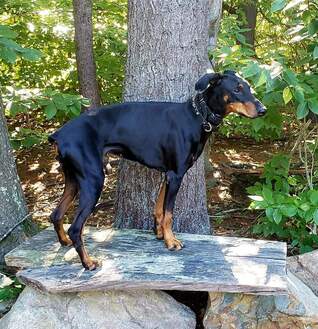
In the beginning non distracting environments are largely controllable by simply training inside in a quiet room without anyone around. The unexpected distraction (spouse, kids, knock on the door, car driving up) may happen, but they are not expected or planned for. For those who also reside in your home, you can let them know not to disturb you when you are training. In those instance, you just have to shoo whoever came in away (or settle the dog after the truck leaves) and find your training footing again to end on a good note.
As you move forward to distractions, environments can be somewhat controlled or predicted for dog training with good planning. Non distracting environments can have creative distractions added to them on purpose.
How to manipulate your non distracting home inside or outside area to work on more distractions:
1) Online programs like YouTube have a ton of audio that you can play to distract your dog. (dogs barking, door bells ringing, door knocking, sounds of people talking, cars, alarm beeps, thunder, doors opening and so on).
2) You could have a known human helper be a "friendly stranger" to practice dog greetings, planned coming in and out of the room, or knock on doors to practice recall and stay.
3) If the weather is nice, you could hang on your porch training your dogs while the normal outside things go on.
4) You could plant garbage bags that wave in the wind outside while training for more distraction.
5) A known friend and responsible dog owner could come over with their dog to provide a distraction.
6) Have a plan should an unexpected distraction come into your yard (dog is on long line for ease of reeling in, gated porch where you can station your dog, ease of access to inside if needed and so on).
NOTE: Don't not start seeking out distracting environments or distractions in familiar environments, until you have an acceptable performance in non distracting environments ( typically 4 in a row performance you are working on out of 5 times consistently).
What to think about and plan for when working in outside environments away from home:
1) Know what outside areas around you have leash laws, if you don't want your dog distracted by off leash dogs. Also know that this is typically the case that dogs are only on leash in those areas.
2) Know what outside areas would typically have no dogs at all (grocery parking lots, fields next to businesses et).
3) Well spread out parks give a lot of area for making space from distractions (generally the farther away a distraction is the less distracting it is to the dog). Usually we work from farther away and then closer and closer to the distraction.
4) Have a plan in case an unexpected distraction comes your way. For instance, I do bring a stick with me in case I encounter either a sketchy off leash dog that is approaching us OR my dog is the reactive one on leash and a friendly off leash dog is approaching. I generally have a good idea on how I can get away (public bathrooms nearby, fences, cars that can be jumped up on if needed). Once you have a plan, you become more comfortable with the unexpected (which is not always bad, but just be prepared).
Remember that you can not start at the end with training. Dogs need to concentrate in minimal distractions first to learn optimally. However, if you want your dog to understand you in multiple environments, then eventually you need to train your dog in multiple environments with a variety of distractions. Just go easy and slow towards those distractions. Have a fun and safe training session.
 RSS Feed
RSS Feed